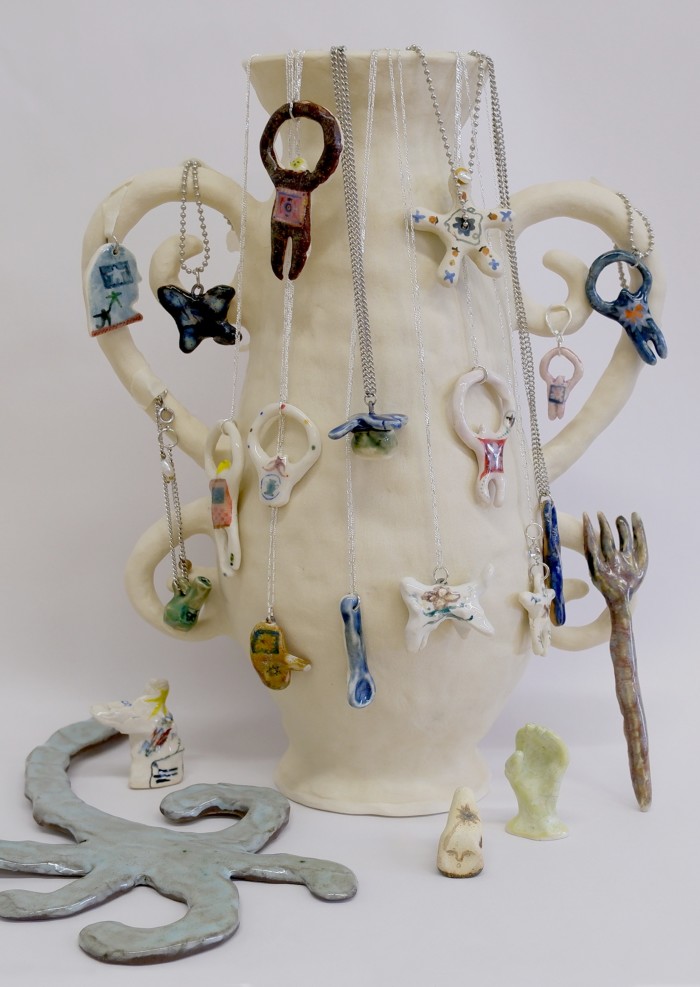How small-batch ceramics became the new Supreme

Roula Khalaf, Editor of the FT, selects her favourite stories in this weekly newsletter.
I happened upon the world of cutthroat ceramics by accident on a recent Sunday afternoon. I remembered it was almost 2pm and suddenly pulled my car over to the side of the road. Ignoring the cries of my children in the backseat, I loaded up the website of Ginny Sims, a Minneapolis-based artisan whose Victorian-meltdown aesthetic had caught my eye on Instagram. She’d mentioned an upcoming sale and I’d taken note, congratulating myself on what I thought was my own private discovery.
I began hitting refresh until the artist’s holding page gave way to a grid of her one-of-a-kind pieces – plates and mugs featuring blurred cameos and landscapes glazed over in a Matisse-ish palette. Bafflingly, the words “SOLD OUT” appeared on top of each item. All that remained was a Sèvres-style teacup that was not exactly my cup of tea. Nevertheless, a sharp-elbowed impulse had kicked in, and I snatched it up. Or tried to. By the time I’d pecked in my credit card information, the object had been claimed by some other mug-hungry monster.
Today, the same level of ruthlessness that accompanies every Yeezy sneaker drop and Telfar bag release has infiltrated the gorgeously clumpy province of pottery. It’s a worldwide phenomenon, from Sims in Minnesota to Mudbelly, the shop of 34-year-old London artist Phoebe Collings-James, where every item is sold out, and to Kendra Yee, a 26-year-old Toronto-based artist, whose fans clamour for her signature “Sour Keys”, which look like anthropomorphic bottle openers.

“You can’t do it like that,” Californian artist Amy Keeler tells me when I relay my Sims experience to her. “These sales are like shark feedings. You need to pre-program your credit card number so you can buy it with one click.”
Keeler’s strategising does not stop at the payment method. She and her partner plan days in advance and decide on the items they will each pounce on when they log on from their separate devices. Keeler logged on to her first Ginny Sims sale in the early days of the pandemic, and hasn’t missed a single one of the last five timed drops (or “dirt drops,” as Haley Bradley of Studio Hecha calls them). “I sit there with my hands shaking and it’s a major adrenaline rush when I get something,” says Keeler, whose desert home now showcases more than 30 pieces by Sims. “I keep saying I have to stop.”
“It’s like trying to buy something from Supreme,” says another ceramics-crazed fan, Rachael Dominguez. “It’s embarrassing to be a grown-up person and this obsessed.” When she failed to snag the Ginny Sims mug that her heart was set on, she made a painting of the salmon vessel with a yellow handle and posted it on her own Instagram account. A fellow follower was so touched that she posted Dominguez an inverse version — with a yellow body and salmon handle. “These mugs transport me to a fantasy world where I live in the Cotswolds and I drink my tea and watch my old lady mysteries and everything is good,” says Dominguez, who lives by the San Francisco airport with her husband and teenage son, a competitive yo-yo player.


Why are so many of us caught in the crosshairs of this ceramics craze? Part of it, surely, is human nature, and the inclination to grab something before it goes. But it goes beyond that. The pieces are both functional and decorative (Sour Key holders wear their treasures as necklace pendants or hide them in their plants). Plus they Zoom beautifully. “There’s a rawness to it,” says Brooklyn-based ceramicist Dustin Barzell, who uses a newsletter to announce his drops, which typically sell out in under five minutes. “You can see the process and humanity in the pieces,” he posits. “People can imagine themselves making the work themselves.”

Skincare entrepreneur Margeaux Gertmenian – the founder of Deep Roots Botanical Goods – surveys the Instagram pages of ceramics-leaning boutiques like Vestige in Philadelphia and Mociun (pronounced “motion”) in Brooklyn, and makes a point of setting the alarm on her phone for drops from her favourite ceramics artists, including Signe Ceramics and Workaday Handmade. “The frenzy is like an old-school sample sale, but it’s a little worse because it’s online so you can’t see who is trying to knock you out.”


I hardly had a chance to get knocked out when I dropped in at another timed sale a few days later. As dinner burnt on the stove, I booted up Suzanne Sullivan’s website. The cult Brooklyn ceramicist had decided to appease her fans with a 6.30pm release of 25 itty-bitty pinch pots, whose intricate zig-zag and spiral designs call to mind ancient cuneiform treasures. Within three minutes, half the wares were gone. Five more minutes, and her homepage was stripped bare.
“Suzanne’s work has brought out a side of me that I didn’t know existed,” says Karen Casey, who lives in Brooklyn. “I’m not a big shopper – I recycle the same four outfits over and over – but when a friend posted a photo of her wine in one of Suzanne’s tumblers, I knew I wanted to get a piece.” Casey now owns five of Sullivan’s works.


The frenzy actually isn’t unique to the shoppers. Barzell can’t help watching the sales from his end as his items vanish in a heartbeat. “It’s stressful but it’s fun,” he says. But the feast-or-famine mindset got to be too much for ceramicist Isabel Halley, who has taken to offering her signature striped wares on a made-to-order basis: “It’s more sustainable,” she explains. The wait time is longer, but she has found her way back to the medium’s grounding essence.
Comments